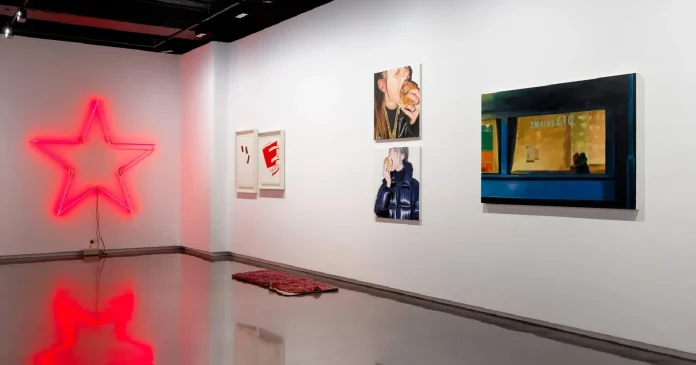In art, the scarcity of capital has always generated alternatives, such as artist residencies, collective workshops, and merch. Fashion could learn from this model. While corporate luxury continues to grow, the recession can open space for independents: brands that thrive on proximity, local networks, and minimal but targeted investments. Realities such as Sarabande in London, which offers residencies and financial support to young creatives, or Café Forgot in New York, which has reinvented retail as a fluid and sustainable space for independent designers, show that another way is possible.
The art world, like the fashion world, is going through a tough time. In fact, according to the Artnet Intelligence Report (September 2025), auction sales in the first six months of the year reached only $4.72 billion, showing a drop of 8.8% compared to the same period in 2024 and a decline of over 40% compared to 2022 levels, a sign of a now structural crisis in the market. But as history teaches us, this is not always an insurmountable problem; it takes time and new strategies. It may seem paradoxical, but every crisis brings innovation. If in fashion the crisis of manufacturing and online retailers is now evident, art too is experiencing a difficult phase, but both worlds can still reinvent themselves.
An exhibition on the art of recessions in London
Thus, the exhibition Don’t Look Back, currently being held at London’s UNIT Gallery, addresses exactly this theme, giving us glimpses of positivity, starting from the principles that connect major recessions with the subsequent birth of fundamental cultural movements. For example, in the United Kingdom, Black Wednesday in 1992 coincided with the peak of the YBA (Young British Artists) movement, whose key figures include Tracey Emin and Damien Hirst. Co-curator Sigrid Kirk, in a recent interview with the Financial Times on the occasion of the exhibition, draws a parallel with the present: «Periods of recession hurt the market but open new spaces for artists, and today artists are starting to collaborate again,» she explains. Together with co-curator Beth Greenacre, she emphasizes this message right at the entrance of the exhibition, where a lively kiosk presents merch (ceramics, clothing, and posters) created by the artists themselves.
The Sarabande Foundation in London
Fashion can respond by transforming merch into a tool for openness and the community into a system of reciprocal and vital exchange. On the other hand, through artist residencies, true nomadic communities that now also include fashion creators. Remaining in the United Kingdom, the Sarabande Foundation, founded in 2006 thanks to Lee Alexander McQueen, was born as a natural extension of his unparalleled sensibility, one capable of turning pain into form. Created to support a new generation of radical creatives, the foundation today offers a rare model of support in the London cultural scene: a program of heavily subsidized residencies, with spaces ranging from 10 to 35 m² rented at the symbolic cost of £1 per m² per month. For the 2024/25 year, Sarabande selected 15 designers for each of its two sites, in Haggerston and Tottenham High Road, for a total of around 30 active residencies. In a recent event, the foundation also brought together about 280 alumni for a pop-up at Selfridges. Even in Italy, we are beginning to move in this direction, with fashion designer residencies emerging thanks to initiatives such as ITS Arcademy in Trieste, which combines training and support for international talents with free courses.
Café Forgot in New York
While residencies are an important step, stores must also foster this eco-economic relationship through the building of strong communities. This is the case with Café Forgot in New York, which embodies all these elements. Founded in 2017 by Vita Haas and Lucy Weisner, both trained in art history, Café Forgot began as a thesis project and defined itself from the start as a community-based shop, where the act of selling coincides with that of sharing. Their practice unfolds between a stable physical space on Ludlow Street and a network of ephemeral activations.
The store hosts reading clubs, film screenings, performances, and moments of shared sociality, where selling intertwines with a widespread cultural program. These activations return a collective dimension to fashion, where the act of purchasing coincides with that of participation, and value arises from relationships rather than production, maintaining a DIY, almost punk aesthetic that rejects minimum orders and production standards. Each object, a dress, a ceramic piece, a jewel, becomes part of an affective micro-community, where value is relational rather than quantitative. In this sense, Café Forgot acts as a form of eco-social activism, a laboratory where the fashion system is reformulated through collaborative practices. As the founders declare, «we provide a space to sell one’s work without the pressure to produce an entire collection.» An affirmation that today sounds like a manifesto.
Subject-groups in fashion
being annoyed is the price you pay for community.
it means having guests when you’d rather be alone. it means letting someone live with you even when they get on your nerves. it means showing up for events that you’d rather not go to. it means turning the other cheek.
— divya venn (@divya_venn) March 1, 2025
In a context of crisis, Café Forgot and Sarabande represent two examples of what French philosopher Félix Guattari would have called «subject-groups»: communities capable of sustaining themselves and generating cultural value outside traditional economic circuits. Café Forgot and the Sarabande Foundation demonstrate that creative communities can still generate cultural and relational value beyond dominant logics. This is where the present can evolve: supporting independent realities, choosing proximity over distance, care over accumulation. In times of recession, true luxury is investing in creativity as it happens, not after it has already been transformed into capital.















